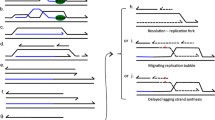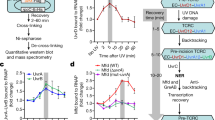Abstract
Mutation frequency decline (MFD) in Escherichia coli was examined to demonstrate repair of targeting photoproducts during the post-UV incubation required in this process. Repair of mutation-targeting cyclobutane pyrimidine dimers (T <> C) was demonstrated when a correlation was established between the mutation frequency normally associated with these lesions and the rate of mutation production at these lesions by spontaneous deamination of cytosines and photoreversal in ung-defective cells. An incubation producing a decline in mutation frequency, i.e., MFD, also produces lower rates of mutation increase via the deamination mechanism. Since the latter assay involves processes entirely within the post-UV incubation period, the lower rates are attributed to rapid transcription-coupled nucleotide excision repair (TCR) that reduces the number of relevant T <> C dimers during this period. Rediscovery of the neglected fact that MFD can be stimulated by post-UV incubation in buffer alone is part of the analysis. Results presented here and a variety of others are discussed to support a model of MFD as a particular example of TCR: effective repair of photoproducts in the transcribed DNA strand that target glutamine tRNA suppressor mutations occurs during the appropriate post-UV incubation and is responsible for MFD.
Similar content being viewed by others
References
Bockrath R, Palmer J (1977) Differential repair of premutational UV-lesions at tRNA genes in E. coli. Mol Gen Genet 156:133–140
Bockrath R, Barlow A, Engstrom J (1987a) Mutation frequency decline in Escherichia coli B/r after mutagenesis with ethyl methanesulfonate. Mutat Res 183:241–247
Bockrath R, Ruiz-Rubio M, Bridges BA (1987b) Specificity of mutation by UV light and delayed photoreversal in umuC-defective Escherichia coli K-12: a targeting intermediate at pyrimidine dimers. J Bacteriol 169:1410–1416
Bockrath R, Hodes MZ, Mosbaugh P, Valerie K, deRiel JK (1988) UV mutagenesis in E. coli with excision repair initiated by uvrABC or denV gene products. Mutat Res 193:87–96
Brash DE, Haseltine WA (1985) Photoreactivation of Escherichia coli reverses umuC induction by UV light. J Bacteriol 163:460–463
Bridges BA, Dennis RE, Munson RJ (1967a) Differential induction and repair of ultraviolet damage leading to true reversion and external suppressor mutations of an ochre codon in Escherichia coli B/r WP2. Genetics 57:897–908
Bridges BA, Dennis RE, Munson RJ (1967b) Mutation in Escherichia coli B/r WP2 tyr− by reversion or suppression of a chain-terminating codon. Mutat Res 4:502–504
Castellani A, Jagger J, Setlow RB (1964) Overlap of photoreactivation and liquid holding recovery in Escherichia coli B. Science 143:1170–1171
Doudney CO, Haas FL (1958) Modification of ultraviolet-induced mutation frequency and survival in bacteria by post-irradiation treatment. Proc Natl Acad Sci USA 44:390–401
Doudney CO, Haas FL (1959) Mutation induction and macromolecular synthesis in bacteria. Proc Natl Acad Sci USA 45:709–721
Engstrom J, Bockrath R (1980) Mutation frequency decline in a rel strain of E. coli B/r. Mol Gen Genet 178:143–147
Engstrom JE, Larsen S, Rogers S, Bockrath R (1984) UV-mutagenesis at a cloned target sequence: converted suppressor mutation is insensitive to mutation frequency decline regardless of the gene orientation. Mutat Res 132:143–152
Fix DF (1986) Thermal resistance of UV-mutagenesis to photoreactivation in E. coli B/r ung: estimate of activation energy and further analysis. Mol Gen Genet 204:452–456
Fix D, Bockrath R (1981) Thermal resistance to photoreactivation of specific mutations potentiated in E. coli B/r ung by ultraviolet light. Mol Gen Genet 182:7–11
Fix D, Bockrath R (1983) Targeted mutation at cytosine-containing pyrimidine dimers: studies of Escherichia coli B/r with acetophenone and 313-nm light. Proc Natl Acad Sci USA 80:4446–4449
Ganesan AK, Smith KC (1968a) Recovery of recombination-deficient mutants of Escherichia coli K-12 from ultraviolet irradiation. Cold Spr Harb Symp Quant Biol 33:235–242
Ganesan AK, Smith KC (1968b) Dark recovery processes in Escherichia coli irradiated with ultraviolet light. I. Effect of rec −mutations on liquid holding recovery. J Bacteriol 96:365–373
Garvey N, Witkin EM, Brash DE (1989) Ultraviolet photoproducts at the ochre suppressor mutation site in the glnU gene of Escherichia coli: relevance to “mutation frequency decline.” Mol Gen Genet 219:359–364
Glickman BW, Schaaper RM, Haseltine WA, Dunn RL, Brash DE (1986) The C-C (6-4) UV photoproduct is mutagenic in Escherichia coli. Proc Natl Acad Sci USA 83:6945–6949
Green MHL, Bridges BA, Eyfjord JE, Muriel WJ (1977) Mutagenic DNA repair in Escherichia coli. V. Mutation frequency decline and error-free post-replication repair in an excision-proficient strain. Mutat Res 42:33–44
Grzesiuk E, Janion C (1994) The frequency of MMS-induced, umuDC-dependent, mutations declines during starvation in Escherichia coli. Mol Gen Genet 245:486–492
Haak RA, Bockrath R (1975) Pyrimidine dimer excision and mutation frequency decline. Rad Res 61:164–171
Hanawalt PC (1989) Preferential repair of damage in actively transcribed DNA sequences in vivo. Genome 31:605–611
Hutchinson F, Yamamoto K, Stein J, Wood RD (1988) Effect of photoreactivation on mutagenesis of lambda phage by ultraviolet light. J Mol Biol 202:593–601
Ito I, Nakamura T, Maki H, Sekiguchi M (1994) Roles of transcription and repair in alkylation mutagenesis. Mutat Res 314:273–285
Kim S-T, Sancar A (1991) Effect of base, pentose, and phosphodiester backbone structures on binding and repair of pyrimidine dimers by Escherichia coli DNA photolyase. Biochem 30:8623–8630
Kristoff S, Bockrath R (1983) Loss of photoreversibility for UV mutation in E. coli using 405 nm and near-UV challenge. Mutat Res 109:143–153
Lemaire DG, Ruzsicska BP (1993) Kinetic analysis of the deamination reactions of cyclobutane dimers of thymidylyl-3′,5′-2′-deoxycytidine and 2′-deoxycytidylyl-3′,5′-thymidine. Biochemistry 32:2525–2533
Li B-H, Bockrath R (1993) Photolyase-dimer-DNA complexes and exclusion stimulation in Escherichia coli: depolarization of the plasma membrane. Mol Gen Genet 240:450–454
Li B-H, Bockrath R (1995) Mutation frequency decline in Escherichia coli. I. Effects by mismatch repair defects. Mol Gen Genet 249:585–590
Li B-H, Larsen S, Pratt V, Bockrath R (1991) Diverse backmutations at an ochre defect in the tyrA gene sequence of E. coli B/r. Mutat Res 246:139–149
Mellon I, Champe GN (1995) Products of DNA mismatch repair genes mutS and mutL are required for transcription-coupled nucleotide excision repair of the lactose operon in Escherichia coli. Proc Natl Acad Sci USA (in press)
Mellon I, Hanawalt PC (1989) Induction of the Escherichia coli lactose operon selectively increases repair of its transcribed DNA strand. Nature 342:95–98
Nakajima N, Ozeki H, Shimura Y (1981) Organization and structure of an E. coli tRNA operon containing seven tRNA genes. Cell 23:239–240
Osborn M, Person S (1967) Characterization of revertants of E. coli WU36-10 and WP2 using amber mutants and an ochre mutant of bacteriophage T4. Mutat Res 4:504–507
Person S, McCloskey JA, Snipes W, Bockrath RC (1974) Ultraviolet mutagenesis and its repair in an Escherichia coli strain containing a nonsense codon. Genetics 78:1035–1049
Person S, Osborn M (1968) The conversion of amber suppressors to ochre suppressors. Proc Natl Acad Sci USA 60:1030–1037
Ruiz-Rubio M, Bockrath R (1989) On the possible role of cytosine deamination in delayed photoreversal mutagenesis targeted at thymine-cytosine dimers in E. coli. Mutat Res 210:93–102
Ruiz-Rubio M, Yamamoto K, Bockrath R (1988) An in vivo complex with DNA photolyase blocks UV mutagenesis targeted at a thymine-cytosine dimer in Escherichia coli. J Bacteriol 170:5371–5374
Sage E, LeDoan T, Boyer V, Hellan DE, Kittler L, Helene C, Moustacchi E (1989) Oxidative DNA damage photoinduced by 3-carbohexypsoralen and other furocoumarins: Mechanism of photo-oxidation and recognition by repair enzymes. J Mol Biol 209:297–314
Sancar A, Sancar GB (1988) DNA repair enzymes. Annu Rev Biochem 57:29–67
Selby CP, Sancar A (1993a) Molecular mechanism of transcription-repair coupling. Science 260:53–58
Selby CP, Sancar A (1993b) Transcription-repair coupling and mutation frequency decline. J Bacteriol 175:7509–7514
Selby CP, Sancar A (1995) Structure and function of transcription-repair coupling factor. I. Structural domains and binding properties. J Biol Chem 270:4882–4889
Selby CP, Witkin EM, Sancar A (1991) Escherichia coli mfd mutant deficient in “Mutation Frequency Decline” lacks strand-specific repair: in vitro complementation with purified coupling factor. Proc Natl Acad Sci USA 88:8232–8236
Setlow JK, Boling ME (1970) Ultraviolet action spectra for mutation in Escherichia coli. Mutat Res 9:437–442
Setlow RB, Carrier WL (1964) The disappearance of thymine dimers from DNA: an error-correcting mechanism. Proc Natl Acad Sci USA 51:226–231
Specht SM, Sideropoulos AS (1990) Effect of phosphate buffer agar on the number of UV-induced mutations to streptomycin resistance in Escherichia coli. Microbios 62:187–195
Tang M-S, Patrick MH (1977a) Repair of UV damage in Escherichia coli under non-growth conditions. Photochem Photobiol 26:247–255
Tang M-S, Patrick MH (1977b) The role of DNA polymerase I in liquid holding recovery of UV-irradiated Escherichia coli. Photochem Photobiol 26:257–262
Witkin EM (1956) Time, temperature and protein synthesis: a study of ultraviolet-induced mutation in bacteria. Cold Spring Harbor Symp Quant Biol 21:123–240
Witkin EM (1963) “Dark repair” of mutations induced in Escherichia coli by ultraviolet light. In: Sobels F (ed) Repair from genetic radiation. Pergamon Press, New York, pp 151–161
Witkin EM (1966) Radiation-induced mutations and their repair. Science 152:1345–1353
Witkin EM (1969) Ultraviolet-induced mutation and DNA repair. Ann Rev Micro 23:487–514
Witkin EM (1994) Mutation frequency decline revisited. BioEssays 16:437–444
Author information
Authors and Affiliations
Additional information
Communicated by R. Devoret
Rights and permissions
About this article
Cite this article
Bockrath, R., Li, B.H. Mutation frequency decline in Escherichia coli. II. Kinetics support the involvement of transcription-coupled excision repair. Molec. Gen. Genet. 249, 591–599 (1995). https://doi.org/10.1007/BF00418028
Received:
Accepted:
Issue Date:
DOI: https://doi.org/10.1007/BF00418028




